|
Notes: Church Talk (Fav. R.C. Churches)
|
|
Church Talk |
View "Favorite"
Churches | Search
"Favorite" Churches |
|
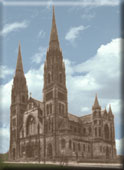
|
Notes:
Church
Talk: "Favorite" Roman Catholic Churches
Terms
of Use | Site
Update | Help | FAQs
|
|
Dear
Friend,
We
have prepared the following chart for your convenience in connection
with the "'Favorite' Roman Catholic Church" view & search
pages. The items below may correspond with the fields located on these
pages and also provide additional information to assist you (e.g.
commentary, quotes
from Scripture / popes / saints / councils, etc. related to the item).
Please note the following:
-
Items in bold text refer to fields/descriptions
on the view & search
pages.
-
Items in small blue text
refer to information on the "add" page (also, small text above the
single line may be from the "add" page).
-
Items
in Courier Text refer to options
available for selection on the "add" page.
-
The notation "Pref."
refers to the most preferred answer for each
field (as applicable). Note: This is a general preference and may not
always be applicable.
Unfortunately,
listing churches with some negative characteristics in this section is unavoidable in
this difficult time. We regret that many churches have experienced destruction at the hands of modernists
/ liberals (called "the worst enemies of the Church" by Bl. Pope Pius IX
and "the most pernicious of all the adversaries of the Church"
by Pope St. Pius X).
To
review/print the helpful flier "Our Responsibilities in God's
House", click
here (Catholic Basics: Resources).
"Unless the LORD build the house, they labor in vain who build."
(Ps.
127:1)
Chrch.Tlk.:
FRCC View/Search Pgs. (Chart)
|
|
"Church
is..." (Opinion of Submitter) Options: Exceptionally Reverent & Beautiful, Exceptionally Reverent,
Exceptionally Beautiful, Other
Church
Name Here
|
General & Building
Information...
|
|
Church
Classification:
"This church is best described
as..."
Options:
Traditional, Conservative / Moderate, Progressive / Liberal,
N/A
What
do these options mean? Do
you allow "progressive" posts? Why options?
Pref.:
Traditional
|
Church
Size:
("select
closest")
Options:
Very Small, Small, Medium, Large, Very Large, N/A
Pref.:
N/A
|
|
When
Built:
"When
was this church built?" (Select first option that
applies)
Options:
Before 1800, Before 1900, Before 1960, After 1960, N/A
Note: Churches built after 1960 may be "less beautiful", "less
God-centered", and "blur the lines between what is sacred and what
is profane". "You
must be able to distinguish between what is sacred and what is
profane, between what is clean and what is unclean" (Lev.
10:10) Pref.:
Any Before 1960
|
Any
Major Renovations Since 1960?
"Any major renovations to this church
since 1960?"
Options:
Yes, No, N/A
Note:
Many post-1960 "renovations" have been deemed "wreckovations"
as sacred articles have been removed / destroyed and church buildings
have been reoriented towards the community and away from God.
"Our
holy and glorious temple in which our fathers praised you has been
burned with fire; all that was dear to us is laid waste." (Isa.
64:10)
Pref.:
No
|
|
Tridentine
Masses:
"Is a Daily Tridentine Mass Offered
Here?" / "Is a Weekly Tridentine Mass Offered
Here?" Daily?
Yes, No, N/A
Weekly?
Yes, No, N/A
Note:
The term "Tridentine Mass" refers to the old Mass
said in Latin (not the new Mass said in Latin). Note that
the "Tridentine Mass" is not the same as the new
Mass. The new Mass (which most of today's Catholics attend) was
created in the 1960's and parallels many of the changes made in
the Protestant Rebellion. The fruits of the new Mass have been
poor and the effects are felt worldwide. Prior to the institution
of the new Mass, Catholics worshiped uniformly in the "Mass
of All Ages", the "Tridentine" Mass. This holy, reverent Mass has been making a
comeback for many years now. Click
here for more information Pref.:
Yes (Daily & Weekly)
|
Architectural
Style (if known):
"Examples: Contemporary/Modern,
Gothic, Baroque, Romanesque, etc."
Pref.:
Other than Contemporary/Modern
|
|
Cathedral
Ceiling?
"Does the church have a
cathedral
ceiling?"
Options:
Yes, No, N/A
Note: A
cathedral ceiling is
very high, open, and is usually slanted (or pointed).
Note:
Churches with great vertical proportions are helpful for directing
one's thoughts toward God.
Pref.:
Yes
|
|
Bell
Tower?
"Does the Church
Have a Bell
Tower?"
Options: Yes, No, N/A
Note: A bell tower is a large
column-like structure rising above the roof of the church which contains a bell (or bells).
Note: Bells have been used for centuries for various purposes,
such as: summoning to prayer, announcing of services, announcing
of deaths/weddings, etc. Their sound is a "welcoming sign" and
both their sound and large structure may help newcomers find the
church. Their tall structure is symbolic and points toward heaven.
Pref.:
Yes
|
|
Dominant
Proportions:
"Would you say that the church is dominated more
by horizontal or vertical proportions?" (see
notes below for assistance)
Options:
Horizontal, Vertical, N/A
"Ask
yourself what is most noticeable inside the church - the height or width
of the church? For example, if you walk in the church and the
ceiling is so high that it seems
to reach to heaven, select 'Vertical'. If the church has
very many seats but is not terribly tall, select 'Horizontal'.
If the proportions are relatively the same, select 'N/A'."
Note:
Churches which emphasize the vertical may be more likely to direct
one's thoughts toward God.
Pref.:
Vertical
|
Any
Moveable/Sliding Walls?
"Are there any moveable (or sliding walls)
inside the church?"
Options: Yes, No, N/A
Note:
Some "modern churches" employ movable/sliding walls.
These may be used, for example, to make the structure more
flexible so that non-sacred events may be held inside the church building.
Sadly, such events may disregard the sacred character of the building and
may lead to the repetition of the lamentation in Macc. 3:51: "For
your sanctuary has been trampled on and profaned, and your priests
are in mourning and humiliation."
Pref.:
No
|
|
Address:
Street
Address
City,
State
Country:
USA
County:
County Name |
Diocese: (Diocese
for Parish)
|
|
Church
Phone: "Parish Phone Number (including area
code)"
|
|
Church
Fax: "Parish Fax Number (including area
code)"
|
|
Pastor's
Name:
"Please
include full name/title (e.g. Monsignor John Harrison, Fr. Mark
Johnson, etc.)"
|
No.
of Priests who Regularly Assist Here:
"Number of priests who regularly assist
here. If there is no
regular/permanent priest assigned to this parish, select '(priestless
parish)'."
Options:
(priestless parish), 1, 2, 3, More Than 3, N/A
Pref.:
(at least one)
|
|
Reminder: Inclusion of information/church/Submitter, etc. herein
does not imply our endorsement. We cannot guarantee accuracy of
any information. Also see "Important Notice" below. |
|
General Atmosphere /
Practices...
|
|
Is
Silence Encouraged Inside the Church?
"Is silence encouraged in this
church?"
Options:
Yes, No, N/A
"Let
all mortal flesh be silent, standing there...in fear and trembling;
for the King of kings, the Lord of lords, Christ our God is about to
be sacrificed and to be given as food to the faithful." (St.
James)
"But the LORD is in his holy temple; silence before him, all the earth!"
(Hab. 2:20)
"Silence, all mankind, in the presence of the LORD! for he stirs forth from his holy dwelling."
(Zech. 2:17)
"As in all the churches of the holy
ones, women should keep silent in the churches, for they are not allowed to speak, but should be subordinate, as even the law says.
But if they want to learn anything, they should ask their husbands at home. For it is improper for a woman to speak in the church."
(St. Paul under the inspiration of the Holy Spirit in 1 Cor.
14:33-35)
Pref.:
Yes
|
Amount
of Women who Generally Wear Head Coverings:
"Amount
of women who generally wear head coverings (e.g. veils) in this
church"
Options:
None, Almost None, Few, Some, Many, Nearly All, All, N/A
"Any
man who prays or prophesies with his head covered brings shame
upon his head. But any woman who prays or prophesies with her head
unveiled brings shame upon her head, for it is one and the same
thing as if she had had her head shaved. For if a woman does not
have her head veiled, she may as well have her hair cut off. But
if it is shameful for a woman to have her hair cut off or her head
shaved, then she should wear a veil. A man, on the other hand,
should not cover his head, because he is the image and glory of
God, but woman is the glory of man. For man did not come from
woman, but woman from man; nor was man created for woman, but
woman for man; for this reason a woman should have a sign of
authority on her head, because of the angels." (St. Paul under the
inspiration of the Holy Spirit in 1 Cor. 11:4-10)
Pref.:
All
|
|
Emphasis:
"This
church emphasizes the..."
Options:
Horizontal, Vertical, N/A
"Select
'Horizontal' if there is a community emphasis (e.g.
if handshaking / socializing / talking in church is permitted, if
kneeling after Communion is not the standard posture for all
the able-bodied, etc.)"
"Select
'Vertical' if the emphasis is on God (e.g. holy
silence permeates church, frequent genuflections and kneeling, no
physical contact with neighbor inside church, etc.)"
"Now
the exhortation of the Apostle, 'Let this mind be in you which was
also in Christ Jesus,' requires that all Christians should
possess, as far as is humanly possible, the same dispositions as
those which the divine Redeemer had when He offered Himself in
sacrifice: that is to say, they should in a humble attitude of
mind, pay adoration, honor, praise and thanksgiving to the supreme
majesty of God." (Pope Pius XII, Mediator Dei) "Enter,
let us bow down in worship; let us kneel before the LORD who made
us." (Ps. 95:6) "Let
all the earth fear the LORD; let all who dwell in the world show
reverence." (Ps. 33:8) "Great
and wonderful are your works, Lord God almighty. Just and true are your ways, O king of the
nations. Who will not fear you, Lord, or glorify your name? For
you alone are holy. All the nations will come and worship before
you, for your righteous acts have been revealed." (Rv.
15:3-4) "But,
assuredly, all of the duties which man has to fulfill, that
without doubt, is the chiefest and holiest which commands him to
worship God with devotion and piety." (Pope Leo XIII) "Holy
things must be treated in a holy way and this sacrifice is the
most holy of all things." (The Council of Trent) Pref.:
Vertical
|
Atmosphere
Inside the Church:
"The general atmosphere inside this church is
better described as"
Options:
Casual, Formal, N/A
Note: Choose closest.
"Common characteristics of a
'Casual'
church atmosphere: talking/noise, casual dress, clapping,
physical contact with others (e.g. handshaking), etc."
"Common characteristics of a
'Formal'
church atmosphere: silence, more formal dress, parishioners facing
forward, etc."
"Give
to the LORD the glory due his name! Bring gifts, and enter his
presence; worship the LORD in holy attire." (1 Chron. 16:29) "But I can enter your house because of your great love.
I can worship in your holy temple because of my reverence for you, LORD."
(Ps. 5:8) "Therefore,
we who are receiving the unshakable kingdom should have gratitude,
with which we should offer worship pleasing to God in reverence
and awe. For our God is a consuming fire." (Heb. 12:28-29) Approach
more reverently than if you "were about to approach all the
rulers in the whole world seated together in one place." (St.
Thomas More) "When
you are before the altar where Christ reposes, you ought no longer
to think that you are amongst men; but believe that there are
troops of angels and archangels standing by you, and trembling
with respect before the sovereign Master of Heaven and earth.
Therefore, when you are in church, be there in silence, fear, and
veneration." (St. John Chrysostom) Pref.:
Formal
|
|
One or More of the Following?
Options: Yes, No, N/A
"Is there one or more of the following at
this church...?"
* Altar girls (female servers)
* Communion in the hand is common
* Sign of Peace during Mass (e.g. handshake)
* Hand-holding during 'Our Father' is common
* Standing during Consecration
* Standing after Communion is common
* Frequent use of Extraordinary Ministers (so-called
"Eucharistic Ministers")
Note:
All items above are a break with long-standing traditions and some
have been condemned by various popes/saints. Some began as an act
of disobedience against the Holy See. Certain "feel
good" practices (e.g. hand-holding, hand-shaking, etc.)
direct attention away from the Holy Sacrifice and onto one's
neighbor. In the early days of the Church, those who were in a
state of mortal sin were not even allowed inside the church
building and
therefore any sign of peace given was truly between those who were
in the peace of Christ. Today, the "sign of peace" may
be given indiscriminately to all persons, even those excluded from
true peace (and thus sends a very wrong message). Try the Latin
Mass & Catholic Tradition section for additional
information. "Wherever
I go in the whole world, the thing that makes me the saddest is
watching people receive Communion in the hand." (Mother
Teresa) "In
the sacramental reception it has always been the custom in the
Church of God that the laity receive Communion from the priests
and that priests who are celebrating Mass give Communion to
themselves. This custom should rightly and deservedly be kept as
coming down from apostolic tradition." (The Council of Trent) Pref.:
No
|
|
Reminder: Inclusion of information/church/Submitter, etc. herein
does not imply our endorsement. We cannot guarantee accuracy of
any information. Also see "Important Notice" below. |
|
Altar / Tabernacle / Seating /
Confessionals...
|
|
Raised
Altar?
"Is the altar
raised?"
Options:
Yes, No, N/A
Note: If the bottom of altar is above
floor level by at least one step, select "Yes", otherwise
select "No".
Note:
An altar should be raised. Altars which are floor level or
lower demote Christ and bring Him down to our level.
Pref.:
Yes
|
Altar
Resembles Traditional Altar or Table?
"Does the altar more resemble a table or a
traditional altar?"
Options:
Table, Traditional Altar, N/A
Note:
An altar should not resemble a table! This is a Protestant concept
which may be used to discourage belief in the Holy Sacrifice of
the Mass. It sends a message that Christ is present only symbolically
in a "community banquet" (i.e. the
Protestants' "Lord's Supper") rather than His Real Presence
in a sacrificial act (the true belief; the Catholic belief).
Pref.:
Traditional Altar
|
|
Altar
Rail?
"Is
there an altar rail separating the Sanctuary from the body of the
church?"
Options:
Yes, No, N/A
Notes: An "altar rail" is also called a "Communion rail". The
Sanctuary is the part of the church containing the altar, the
pulpit, etc.
Note:
Modernists reject the altar rail as it provides a distinction
between the priest and the laity. Rather than honor the special
power given exclusively to the ordained, these modernists prefer
for everyone to be "equal". They, sadly, also
reject the altar rail since they prefer for everyone to stand
rather than kneel to
receive the Holy Eucharist. Pref.:
Yes
|
Side
Altar(s)?
"Are
there any side altars?"
Options:
Yes, No, N/A
Note: If there is more than one
altar (e.g. one in front of the church and one at the side of the
church), select "Yes". Otherwise, select "No".
Note:
Larger churches are more likely to have side alters.
Unfortunately, the modernists have removed/destroyed many side
altars in recent years. Pref.:
Yes (if large enough church)
|
|
Location
of Tabernacle:
"Location of the
Tabernacle"
Options:
Front Of Church, Off To Side, Other (Inside Church), Other (Outside
Church), No Tabernacle, N/A
Note: If the only Tabernacle at
the parish is located in a chapel which is separate from the church, select "other (outside
church)".
Note:
The Tabernacle - which contains the true Body & Blood of our
Lord - God Himself! - should be given prominence and not hidden
off to the side (or removed from the church altogether).
Pref.:
Front of Church
|
Tabernacle
Located Prominently Inside Church?
"Is the Tabernacle located prominently inside
the church?"
Options:
Yes, No, N/A
Note:
The Tabernacle is an enclosure (typically over a foot tall) which houses the Holy Eucharist.
Note:
The missing Tabernacles present in many Catholic churches today
make many repeat Mary Magdalene's lament in John 20:13,
"They have taken my Lord, and I don't know where they laid
him." Pref.:
Yes
|
|
Tabernacle
Clearly Visible From Back of Church?
"Is the Tabernacle clearly visible from the back
of the church?"
Options:
Yes, No, N/A
Note:
If the Tabernacle is screened off (even if it is in the front
of the church), select "No".
Reminder:
The Tabernacle is an enclosure (typically over a foot tall) which houses the Holy Eucharist.
Note:
It is important that even those in the back of the church clearly
see the sacred housing of the precious Body and Blood of our
Lord.
Pref.:
Yes
|
Tabernacle
on Altar?
"Does the Tabernacle Sit on the
Altar?" Options:
Yes, No, N/A
Note:
"On altar" may mean directly on the altar or directly behind
the main altar.
"To
separate the Tabernacle from the Altar is tantamount to separating
two things which, of their very nature, must remain together" (Pope Pius XII).
Pref.:
Yes
|
|
Tabernacle
Type:
"The Tabernacle at this church is better described
as..."
Options:
Fancy / Ornate, Plain / Modest, N/A
Note: Choose closest
Note:
The Tabernacle should be magnificent, in consideration of what it
contains. Pref.:
Fancy / Ornate
|
Seating
Arrangement:
"Seating arrangement inside
church"
Options:
Traditional, U-Shaped, Circular, Semi-Circular, Angular, Other
(Non-Traditional), N/A
Note: For fan-shaped, select "Semi-Circular". Traditional
seating has pews on both sides of the main center isle that face
directly toward the altar. In a traditional seating arrangement (for
our purposes), no pews would face the side of the altar or be at an
angle.
Note:
Modernists prefer seating arrangements which emphasize the
community rather than those which facilitate the adoration of God. Pref.:
Traditional
|
|
Type
of Seating:
"Type of seating for
congregation"
Options:
Pews (with kneelers), Pews (without kneelers), Chairs, Other, N/A
Note: If more than one type of
seating, choose predominant type.
Note:
In recent years, Modernists have abominably ripped out pews with
kneelers in favor of folding chars. Although they did it
mockingly, even those who participated in the Passion knew that
kneeling was the proper posture for encounters with a king: "Weaving a crown out of thorns, they placed it on his head, and a reed in his right hand. And
kneeling before him, they mocked him, saying, "Hail, King of the Jews!"
(Mt. 27:29) (emphasis added) Pref.:
Pews (with kneelers)
|
Kneelers
Inside Church:
"Kneelers inside
church"
Options:
Kneelers Throughout, Most Areas Have Kneelers, Some Kneelers, Few
Kneelers, No Kneelers, N/A
Note:
A kneeler is a bar (often padded) - either fixed or fold-down - in
front of the pews/seats that the congregation uses to kneel on.
Note:
If a church doesn't have kneelers, you should still kneel if you
are physically able (bring a kneepad). "Standing may be
for reverence, but kneeling is for worship."
"It
is, therefore, the keen desire of the Church that all of the
faithful kneel at the feet of the Redeemer to tell Him how much they
venerate and love Him." (Pope Pius XII, Mediator Dei)
"All
who sleep in the earth will bow low before God; All who have gone
down into the dust will kneel in homage." (Ps. 22:30)
"Enter,
let us bow down in worship; let us kneel before the LORD who made
us." (Ps. 95:6)
"At
the name of Jesus every knee should bend, of those in heaven and on
earth and under the earth, and every tongue confess that Jesus
Christ is Lord, to the glory of God the Father." (Phil. 2:10-11)
Pref.:
Kneelers Throughout
|
|
Traditional
Confessionals:
"Number of traditional style
confessionals"
Options:
0, 1, 2, 3, More Than 3, N/A
Note: Traditional style
confessionals are small "boxes" (or
"little booths") which (usually) contain a fixed screen
and a kneeler. They are anonymous and may be dark and somewhat
"confining". Only one person fits in the
confessional. (The Sacrament of Penance is done here.)
Note:
Traditional confessionals help create an atmosphere proper to the
confession of one's sins; sins which destroy our friendship with
God and (if not forgiven) may cause us to suffer eternal hellfire.
"For the wages of sin is death" (Rom. 6:23). Pref.:
One or More
|
'Reconciliation
Rooms':
"Number of modern style
'reconciliation
rooms'"
Options:
0, 1, 2, 3, More Than 3, N/A
Note: Modern "reconciliation
rooms" are more "open and casual". They are the size
of a small room and can fit two people (the priest & the penitent).
They may contain a chair or a kneeler and may have a curtain or
screen. They may be well-lit.
(The Sacrament of Penance is done here.)
Note:
The casualness and "friendliness" of so-called "Reconciliation
Rooms" may be less conducive to the proper penitential spirit
one should have regarding sins. Instead of asking how we have
offended God, they prompt us to ask (even literally) "How do
we feel about our sin?", "Are we at peace with
ourselves?", etc. This is a much different perspective than
that of our Lord's in Mt. 5:29-30. "If your right eye causes you to sin, tear it out and throw it away. It is better for you to lose one of your members than to have your whole body thrown into
Gehenna. And if your right hand causes you to sin, cut it off and throw it away. It is better for you to lose one of your members than to have your whole body go into
Gehenna." Important note: Don't take the above literally.
Contact a good priest for assistance in applying this Scripture
passage. Pref.:
0
|
|
Reminder: Inclusion of information/church/Submitter, etc. herein
does not imply our endorsement. We cannot guarantee accuracy of
any information. Also see "Important Notice" below. |
|
Decoration, Appointments,
Etc...
|
|
Prominent
Image Behind Altar:
"The front of the church
(behind the altar)
contains a..."
Options:
Large Crucifix, Medium/Small Crucifix, Plain Cross, Risen Jesus
Image, (no image), Other, N/A
Note: This
refers to the most prominent image, not to smaller images. Note:
A cross must contain an image of a crucified Jesus to be considered
a Crucifix. If there is no corpus (body of Jesus) attached to the
cross, select "Plain Cross". If the image of Jesus
attached to the cross is a resurrected Jesus, select "Risen
Jesus Image".
Note: Given that the Mass is a propitiatory Sacrifice, the most
appropriate image is that of our Crucified Lord. Other images tend
to confuse / reduce the seriousness and solemnity of the sacred
act.
Pref.:
Large Crucifix
|
Stained
Glass Windows Contain Mostly:
"Stained glass windows (if any) mostly
contain..."
Options:
Holy Images, Other Images, (no stained glass), N/A
Note: Holy images include
pictures of Christ, the Saints, Bible events, etc. Other images
include earthy items (e.g. plants, water, wheat, grapes, etc.), patterns, etc. If
there is no stained glass, select "(no stained glass)".
Note:
Holy images help lift our minds to God. Other images (e.g. plants,
water, wheat, grapes, etc.) tend to direct our attention to
earthly things. Pref.:
Holy Images
|
|
Stations
of the Cross?
"Are there Stations of the Cross inside
the church?"
Options:
Yes, No, N/A
Note: Stations of the Cross are
a collection of fourteen crosses (usually with images depicting Jesus' journey to Calvary
from His condemnation to His burial). They are usually located on the sides of
the church.
"The
object of the Stations is to help the faithful to make in spirit,
as it were, a pilgrimage to the chief scenes of Christ's
sufferings and death, and this has become one of the most popular
of Catholic devotions... In conclusion it may be safely asserted
that there is no devotion more richly endowed with indulgences
than the Way of the Cross, and none which enables us more
literally to obey Christ's injunction to take up our cross and
follow Him." (The Catholic Encyclopedia)
Pref.:
Yes
|
Holy
Water Font Style:
"Holy Water Font
Style"
Options:
Traditional Font(s), Large Basin / Pool, No Fonts, Other, N/A
Note: This refers to the holy
water fonts located inside the church (usually found to the left or
right as soon as you walk in).
Note:
Holy water should remind us of the glorious gift of our Baptism. Unfortunately,
some large basins/pools of holy water seem to reflect an attitude of
"fun" rather than direct our attention towards this
greatest of gifts. Pref.:
Traditional Font(s)
|
|
Amount
of Votive Candles Inside the Church:
"Amount of Votive Candles Inside the Church"
Options:
Many, Some, Few, None, N/A
Note: Votive candles are large
or small candles usually located near statues inside the church.
They may be real or artificial candles.
Note:
The burning of candles is a long-standing tradition (and even
dates back to Old Testament times). Candles symbolize
self-sacrifice and the placing of a prayer before God. The orange
glow, the smoke rising up, and the candle wicks may have all have
symbolic meaning. Pref.:
Many (or at least some)
|
Type
of Votive Candles:
"Type of Votive Candles Inside the
Church"
Options:
(no votive candles), Real Candles, Artificial Candles, N/A
Note: If there are no votive
candles inside the church, select "(no votive candles)".
Select "Real Candles" if the candles are real (e.g.
are wax and contain a real flame). If the candles are artificial
(e.g. electric), select "Artificial Candles".
Note: Artificial candles are designed to be re-used by numerous
individuals rather than being consumed. Real candles have symbolic
meaning that artificial candles can never have (e.g. the candle
burning itself out symbolizes self-sacrifice) and help create a
holy atmosphere that cannot be duplicated by artificial candles
(smell, smoke, orange glow, natural flickering, etc.).
Pref.: Real
Candles
|
|
Pipe
Organ Inside the Church?
"Is There a Pipe Organ Inside the
Church?"
Options:
Yes, No, N/A
Note:
A pipe organ is a very large (or huge) musical instrument containing
rows of large metal (or wooden) pipes. ("If you saw
one, you would know right away that it was a pipe organ.")
Note:
Called "the premier instrument" of the Catholic Church,
the pipe organ has historically been considered "the only instrument
sacred enough for the Mass". As Pope St. Pius X said on November
22, 1903, "The employment of the piano is forbidden in
church, as is also that of noisy or frivolous instruments such as
drums, cymbals, bells and the like." Even Vatican II states
that, "In the Latin Church the pipe organ is to be held in
high esteem, for it is the traditional musical instrument which
adds a wonderful splendor to the Church's ceremonies and
powerfully lifts up man's mind to God". It is difficult to see how drums and other
such instruments could be considered "solemn", but
rather seem to "diminish the piety... (and offend)... the decorum
and sanctity of the sacred functions" (Pope St. Pius X). As
Pope Pius XII indicated, "the Church must insist that this
(musical) art remain within its proper limits and must prevent
anything profane and foreign to divine worship from entering into
sacred music along with genuine progress, and perverting it" and
that "the chants and sacred music which are immediately
joined with the Church's liturgical worship should be conducive to
the lofty end for which they are intended. This music - as our
predecessor (St.) Pius X has already wisely warned us - 'must
possess proper liturgical qualities, primarily holiness and
goodness of form; from which its other note, universality, is
derived.' It must be holy. It must not allow within itself
anything that savors of the profane nor allow any such thing to
slip into the melodies in which it is expressed." Pref.:
Yes
|
Choir
Location:
"Choir
Location" Options:
Back Of Church, Side Of Church, Front Of Church (left or right
side), Front Of Church (center), N/A
Note:
Placing the choir loft in the rear of the church often provides superior
acoustics and does not distract the congregation. It may also be representative
of "voices coming down from heaven". The closer the
choir is moved towards the altar, the more likely that it may
become a distraction. A prominent choir may also reduce the
atmosphere of sacredness and may tend to be viewed as entertainment. Pref.:
Back of Church
|
|
No.
of Holy Images Inside Church (approx.):
"Approximate number of holy images inside the church
(not counting stained glass windows and Stations of the Cross)"
Options:
0, 1, 2, 3, 4, 5, 6, 7, 8, 9, 10, More Than 10, N/A
Note: Holy
images include crucifixes, statues/pictures of Christ, the Saints,
Bible events, etc. Do not count earthy images (e.g. plants,
water, wheat, grapes, etc.), patterns, etc.
Note that a single picture
containing ten Bible scenes would be counted as one holy image for
our purposes here.
Note:
Unfortunately, it is not uncommon to find that Modernists have
removed and even destroyed sacred images from Catholic churches.
Sometimes church buildings are left so barren that they appear to
belong to Protestants. Although they cite Vatican II for this
destruction, the documents of Vatican II state: "Ordinaries
must be very careful to see that sacred furnishings and works of
value are not disposed of or dispersed; for they are the ornaments
of the house of God."
"[F]ollowing
the divinely inspired teaching of our Holy Fathers, and the
tradition of the Catholic Church, for we know that this is of the
Holy Spirit who certainly dwells in her, define in all certitude
and diligence that as the figure of the honored and life-giving
Cross, so the venerable and holy images...must be suitably placed
in the holy churches of God, both on sacred vessels and vestments,
and on the walls and on the altars, at home and on the streets,
namely such images of our Lord Jesus Christ, God and Savior, and
of our undefiled lady, or holy Mother of God, and of the honorable
angels, and, at the same time, of all the saints and of holy men.
For, how much more frequently through (artistic representation) they are seen, so much more quickly are those
who contemplate these, raised to the memory and desire of the
originals of these, to kiss and to render honorable adoration to
them, not however, to grant true latria according to our faith,
which is proper to divine nature alone" (Second
Council of Nicaea,
787 A.D.)
"We
declare that we preserve intact all the written and unwritten
traditions of the Church which have been entrusted to us. One of
these traditions consists in the production of representational
artwork, which accords with the history of the preaching of the
Gospel. For it confirms that the incarnation of the Word of God
was real and not imaginary, and to our benefit as well, for
realities that illustrate each other undoubtedly reflect each
other's meaning." (Second Council of
Nicaea,
787 A.D.) Pref.:
(higher is better)
|
No.
of Holy
Images in the Sanctuary:
"Number of holy images in the
Sanctuary"
Options:
0, 1, 2, 3, 4, 5, 6, 7, 8, 9, 10, More Than 10, N/A
Note: Holy
images include crucifixes, statues/pictures of Christ, the Saints,
Bible events, etc. Do not count earthy images (e.g. plants,
water, wheat, grapes, etc.), patterns, etc.
Note that a single picture containing ten Bible scenes would be
counted as one holy image for our purposes here.
Reminder: The Sanctuary is the part of the church containing the altar, the pulpit, etc.
"The
beauty of the images moves me to contemplation, as a meadow
delights the eyes and subtly infuses the soul with the glory of
God." (St. John Damascene) Pref.:
(several)
|
|
Large Mary Statue Inside Church?
"Is there a large statue of Mary inside the
church?"
Options:
Yes, No, N/A
Note:
Unfortunately, Modernists tend to have an aversion to Mary.
Sometimes Vatican II is used as an excuse. However, this is not
the teaching of Vatican II. As stated in Vatican II documents: "This
most Holy Synod deliberately teaches this Catholic doctrine and at
the same time admonishes all the sons of the Church that the cult,
especially the liturgical cult, of the Blessed Virgin, be
generously fostered, and the practices and exercises of piety,
recommended by the magisterium of the Church toward her in the
course of centuries be made of great moment, and those decrees,
which have been given in the early days regarding the cult of
images of Christ, the Blessed Virgin and the saints, be
religiously observed." Pref.:
Yes
|
Small
or Medium Sized Mary Statue Inside Church?
"Is there a small or medium sized statue of Mary
inside the church?"
Options:
Yes, No, N/A
Note:
Unfortunately, Modernists tend to have an aversion to Mary.
Sometimes Vatican II is used as an excuse. However, this is not
the teaching of Vatican II. As stated in Vatican II documents: "This
most Holy Synod deliberately teaches this Catholic doctrine and at
the same time admonishes all the sons of the Church that the cult,
especially the liturgical cult, of the Blessed Virgin, be
generously fostered, and the practices and exercises of piety,
recommended by the magisterium of the Church toward her in the
course of centuries be made of great moment, and those decrees,
which have been given in the early days regarding the cult of
images of Christ, the Blessed Virgin and the saints, be
religiously observed." Pref.:
Yes (or a large one)
|
|
No.
of Saint Statues Inside Church (approx.):
"Total number of saint statues inside the church
(not counting statues of Mary)"
Options:
0, 1, 2, 3, 4, 5, 6, 7, 8, 9, 10, More Than 10, N/A
"[F]ollowing
the divinely inspired teaching of our Holy Fathers, and the
tradition of the Catholic Church, for we know that this is of the
Holy Spirit who certainly dwells in her, define in all certitude
and diligence that as the figure of the honored and life-giving
Cross, so the venerable and holy images...must be suitably placed
in the holy churches of God, both on sacred vessels and vestments,
and on the walls and on the altars, at home and on the streets,
namely such images of our Lord Jesus Christ, God and Savior, and
of our undefiled lady, or holy Mother of God, and of the honorable
angels, and, at the same time, of all the saints and of holy men.
For, how much more frequently through (artistic representation) they are seen, so much more quickly are those
who contemplate these, raised to the memory and desire of the
originals of these, to kiss and to render honorable adoration to
them, not however, to grant true latria according to our faith,
which is proper to divine nature alone" (Second
Council of Nicaea,
787 A.D.) "If
anyone does not confess that Christ our God can be represented in
His humanity, let him be anathema. If anyone does not accept
representation in art of evangelical scenes, let him be anathema.
If anyone does not salute such representations as standing for the
Lord and His saints, let him be anathema." (Second
Council of Nicaea,
787 A.D.) "Those,
therefore, who dare to think or to teach otherwise or to spurn
according to wretched heretics the ecclesiastical traditions and
to invent anything novel, or to reject anything from these things
which have been consecrated by the Church: either the Gospel or
the figure of the Cross, or the (representational) picture, or the sacred
relics of the martyr; or to invent perversely and cunningly for
the overthrow of any one of the legitimate traditions of the
Catholic Church; or even, as it were, to use the sacred vessels or
the venerable monasteries as common things; if indeed they are
bishops or clerics, we order (them) to be deposed; monks, however,
or laymen, to be excommunicated." (Second Council of Nicaea,
787 A.D.) Pref.:
(higher is better)
|
Statues
Inside Church Best Described As:
"The statues inside the church are best
described as"
Options:
Traditional / True-To-Life, Modern / Symbolic / Artistic, N/A
Note:
In the name of Vatican II, some Modernists have introduced in
Catholic churches images and statues that may fairly be described
as appalling. However, this is not in
keeping with the teaching of Vatican II. As stated in the
documents of Vatican II: "Holy Mother Church has therefore
always been the friend of the fine arts and has ever sought their
noble help, with the special aim that all things set apart for use
in divine worship should be truly worthy, becoming, and beautiful,
signs and symbols of the supernatural world...The Church has been
particularly careful to see that sacred furnishings should
worthily and beautifully serve the dignity of worship" and "Let
bishops carefully remove from the house of God and from other
sacred places those works of artists which are repugnant to faith,
morals, and Christian piety, and which offend true religious sense
either by depraved forms or by lack of artistic worth, mediocrity
and pretense." Pref.:
Traditional / True-To-Life
|
|
Interior
Decoration:
"Interior decoration of the church is best
described as...(choose closest)"
Options:
Ornate, Medium, Plain / Sparse, N/A
This refers to
permanent decorations and not banners, signs, etc.
Note:
Unfortunately, it is not uncommon to find that Modernists have
removed and even destroyed sacred items from Catholic churches.
Sometimes church buildings are left so barren that they appear to
belong to Protestants. Although they cite Vatican II for this
destruction, the documents of Vatican II state: "Ordinaries
must be very careful to see that sacred furnishings and works of
value are not disposed of or dispersed; for they are the ornaments
of the house of God." "[F]ollowing
the divinely inspired teaching of our Holy Fathers, and the
tradition of the Catholic Church, for we know that this is of the
Holy Spirit who certainly dwells in her, define in all certitude
and diligence that as the figure of the honored and life-giving
Cross, so the venerable and holy images...must be suitably placed
in the holy churches of God, both on sacred vessels and vestments,
and on the walls and on the altars, at home and on the streets,
namely such images of our Lord Jesus Christ, God and Savior, and
of our undefiled lady, or holy Mother of God, and of the honorable
angels, and, at the same time, of all the saints and of holy men.
For, how much more frequently through (artistic representation) they are seen, so much more quickly are those
who contemplate these, raised to the memory and desire of the
originals of these, to kiss and to render honorable adoration to
them, not however, to grant true latria according to our faith,
which is proper to divine nature alone" (Second
Council of Nicaea,
787 A.D.) "Whoever
takes away or intends to take away what other faithful have given
from the heritage of their possessions for the care of their
souls, the honor of God, the beauty of His Church and the use of
its ministers, assuredly turns the gifts of others into danger for
his own soul." (Pope
Pius VII, quoting the Synod of Aachen) Pref.:
Ornate
|
Most
Artwork Is:
"Most artwork inside the church is best
described as"
Options:
Realistic / True-To-Life, Symbolic / Artistic, N/A
Note:
In the name of Vatican II, some Modernists
have introduced in Catholic churches "artwork" that may
fairly be described as appalling. However,
this is not in keeping with the teaching of Vatican II. As stated
in the documents of Vatican II: "Holy Mother Church has
therefore always been the friend of the fine arts and has ever
sought their noble help, with the special aim that all things set
apart for use in divine worship should be truly worthy, becoming,
and beautiful, signs and symbols of the supernatural world...The
Church has been particularly careful to see that sacred
furnishings should worthily and beautifully serve the dignity of
worship" and "Let bishops carefully remove from the
house of God and from other sacred places those works of artists
which are repugnant to faith, morals, and Christian piety, and
which offend true religious sense either by depraved forms or by
lack of artistic worth, mediocrity and pretense." Pref.:
Realistic / True-To-Life
|
|
Traditional
Artwork:
"How much of the artwork inside the church is traditional?"
Options:
All, Most, Some, None, N/A
"[F]ollowing
the divinely inspired teaching of our Holy Fathers, and the
tradition of the Catholic Church, for we know that this is of the
Holy Spirit who certainly dwells in her, define in all certitude
and diligence that as the figure of the honored and life-giving
Cross, so the venerable and holy images...must be suitably placed
in the holy churches of God, both on sacred vessels and vestments,
and on the walls and on the altars, at home and on the streets,
namely such images of our Lord Jesus Christ, God and Savior, and
of our undefiled lady, or holy Mother of God, and of the honorable
angels, and, at the same time, of all the saints and of holy men.
For, how much more frequently through (artistic representation) they are seen, so much more quickly are those
who contemplate these, raised to the memory and desire of the
originals of these, to kiss and to render honorable adoration to
them, not however, to grant true latria according to our faith,
which is proper to divine nature alone" (Second
Council of Nicaea,
787 A.D.) "[S]acred
furnishings should worthily and beautifully serve the dignity of
worship" (Second Vatican Council) "Those,
therefore, who dare to think or to teach otherwise or to spurn
according to wretched heretics the ecclesiastical traditions and
to invent anything novel, or to reject anything from these things
which have been consecrated by the Church: either the Gospel or
the figure of the Cross, or the (representational) picture, or the sacred
relics of the martyr; or to invent perversely and cunningly for
the overthrow of any one of the legitimate traditions of the
Catholic Church; or even, as it were, to use the sacred vessels or
the venerable monasteries as common things; if indeed they are
bishops or clerics, we order (them) to be deposed; monks, however,
or laymen, to be excommunicated." (Second Council of Nicaea,
787 A.D.) Pref.:
All
|
Modern
Artwork:
"How much of the artwork inside the church is modern?"
Options:
All, Most, Some, None, N/A
Note:
"Modern artwork" for purposes of this question includes
1960's style and 1970's
style (and later) artwork.
Note:
In the name of Vatican II, some Modernists have introduced in Catholic churches "artwork" that may
fairly be described as appalling. However,
this is not in keeping with the teaching of Vatican II. As stated
in the documents of Vatican II: "Holy Mother Church has
therefore always been the friend of the fine arts and has ever
sought their noble help, with the special aim that all things set
apart for use in divine worship should be truly worthy, becoming,
and beautiful, signs and symbols of the supernatural world...The
Church has been particularly careful to see that sacred
furnishings should worthily and beautifully serve the dignity of
worship" and "Let bishops carefully remove from the
house of God and from other sacred places those works of artists
which are repugnant to faith, morals, and Christian piety, and
which offend true religious sense either by depraved forms or by
lack of artistic worth, mediocrity and pretense." Pref.:
None
|
|
External
Appearance:
"The external appearance of this church is
better described as..."
Options:
Simple / Plain, Fancy / Elegant, N/A
Note: Choose closest
"[Y]ou
should undoubtedly always give special attention to the beauty of
the house of God and the splendor and dignity of objects dedicated
to the divine service. Such beauty and splendor often greatly
inspire the faithful, and draw them to the veneration of sacred
realities." (Pope Pius VI) "[T]he
house that is to be built for the LORD must be made so magnificent
that it will be renowned and glorious in all countries."
(King David, 1 Chron. 22:5) Pref.:
Fancy / Elegant
|
Outside
Beauty:
"What
best describes the physical beauty of this church (from the
outside)?"
Options:
Extremely Beautiful, Very Beautiful, Beautiful, Kind of Beautiful,
Ordinary, N/A
Note:
Choose closest.
"[Y]ou
should undoubtedly always give special attention to the beauty of
the house of God and the splendor and dignity of objects dedicated
to the divine service. Such beauty and splendor often greatly
inspire the faithful, and draw them to the veneration of sacred
realities." (Pope Pius VI) "[T]he
house that is to be built for the LORD must be made so magnificent
that it will be renowned and glorious in all countries."
(King David, 1 Chron. 22:5) Pref.:
(the more beautiful the better)
|
|
Internal
Appearance:
"The internal appearance of this church is
better described as..."
Options:
Simple / Plain, Fancy / Elegant, N/A
Note: Choose closest
"[Y]ou
should undoubtedly always give special attention to the beauty of
the house of God and the splendor and dignity of objects dedicated
to the divine service. Such beauty and splendor often greatly
inspire the faithful, and draw them to the veneration of sacred
realities." (Pope Pius VI) "[T]he
house that is to be built for the LORD must be made so magnificent
that it will be renowned and glorious in all countries."
(King David, 1 Chron. 22:5) Pref.:
Fancy / Elegant
|
Inside
Beauty:
"What
best describes the physical beauty of this church (from the inside)?"
Options:
Extremely Beautiful, Very Beautiful, Beautiful, Kind of Beautiful,
Ordinary, N/A
Note:
Choose closest.
"[Y]ou
should undoubtedly always give special attention to the beauty of
the house of God and the splendor and dignity of objects dedicated
to the divine service. Such beauty and splendor often greatly
inspire the faithful, and draw them to the veneration of sacred
realities." (Pope Pius VI) "[T]he
house that is to be built for the LORD must be made so magnificent
that it will be renowned and glorious in all countries."
(King David, 1 Chron. 22:5) Pref.:
(the more beautiful the better)
|
|
Reminder: Inclusion of information/church/Submitter, etc. herein
does not imply our endorsement. We cannot guarantee accuracy of
any information. Also see "Important Notice" below. |
|
Special Characteristics (if
applicable)...
|
|
"List any special characteristics of this church (optional)"
(e.g. historical significance, relics, other unusual/special
characteristics)
"[Y]ou
should undoubtedly always give special attention to the beauty of
the house of God and the splendor and dignity of objects dedicated
to the divine service. Such beauty and splendor often greatly
inspire the faithful, and draw them to the veneration of sacred
realities." (Pope Pius VI) "Those,
therefore, who dare to think or to teach otherwise or to spurn
according to wretched heretics the ecclesiastical traditions and to
invent anything novel, or to reject anything from these things which
have been consecrated by the Church: either the Gospel or the figure
of the Cross, or the (representational) picture, or the sacred relics of the
martyr; or to invent perversely and cunningly for the overthrow of
any one of the legitimate traditions of the Catholic Church; or even,
as it were, to use the sacred vessels or the venerable monasteries
as common things; if indeed they are bishops or clerics, we order
(them) to be deposed; monks, however, or laymen, to be
excommunicated." (Second Council of Nicaea,
787 A.D.) |
|
Reminder: Inclusion of information/church/Submitter, etc. herein
does not imply our endorsement. We cannot guarantee accuracy of
any information. Also see "Important Notice" below. |
Important
Notice: Inclusion of information/church/Submitter, etc. herein
does not imply our endorsement. Above information may be provided by
various source(s). We cannot
guarantee accuracy of any information. You should assume that no
information contained herein has been verified. Information herein
is not comprehensive and may be relative and/or subjective. All
items are subject to change at any time without notice (note that
churches may change at any time, especially if there is a change
of bishop or priest). We do not endorse any church (even if it
appears here). We are not affiliated with churches listed herein and cannot
endorse/recommend them. Religious affiliation of churches may not be verified. Users are advised to research
churches independently before visiting/attending any
services/contacting them, etc. Unfortunately, some churches may be
Catholic in name only as even members of the clergy may not
always expound the True Faith. Users are cautioned that certain
churches might actually be harmful to the faithful.
Visit/attend/contact, etc. at your own risk. Use of this site is
subject to our terms of use. Note: Catholic churches are holy
places and should not be treated in a "touristy" manner
(however, we recognize that beauty can have a positive effect on
worship).
|
Note: Translations
may vary. The
above is not comprehensive. Above items may be subjective. All items /
pages / terms, etc. are subject to change without
notice. Visit applicable pages for current versions. Reminder: We make
no guarantees regarding any item herein. By using this site you indicate
agreement to all terms. For more terms information, click
here.
How
are records ordered? | Explain
Traditional / Conservative, etc. | How
long do records appear here? | How
to find records | Why
doesn't my post appear? | How
can I post here? | Terms
of Use | More FAQs...
Also see links at top of page
|
|
|
|
|
|
|
|
|
Catholic Books & Ebooks
Click Here
|
|
Reflections (Wisdom From Popes & Saints)
Click Here
|
|
'Quick Help' Pages
Click Here
|
|
Need Help?
'Live Chat'
Click Here
|

Home
MCS Daily Digest
Quick Guide to This Site
What's New
Reception Desk
Notices
Topic Pages
'Quick Help' Pages
Books / Ebooks |
Kindle Scribe Books
Apps
Reflections
Help |
'Live Chat'
Coming Soon
Featured Sections
URL Shortcuts
Calendar
Goals / Purpose
This site is really free?
How can I add a "post" here?
Mission Statement
Privacy Statement
Imprimatur Information
Terms of Use
by using this site, you agree to all terms
MCS Directory
Community Center
Commercial Areas
Non-Catholics
About Us
FAQs
Tell a Friend
Invite a Business
Link to Us
My Catholic Source.com Blog & RSS Feed Info.
Third Party Programs
Awards
Feedback
Contact Us
This site powered by
bfsnet.com

|
|
Now Available!
Catholic Word Search - JUMBO Edition
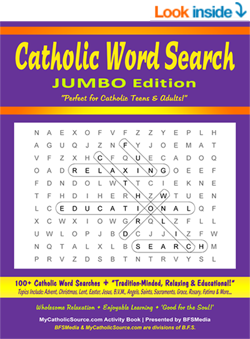
(Original)
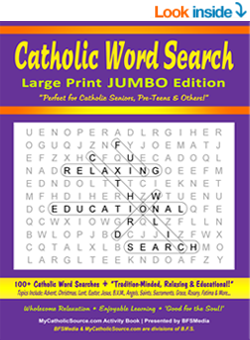
(Large Print Edition)
100+ Catholic Word Searches (Incl. Advent,
Christmas, Lent, Easter, Jesus, B.V.M., Angels, Saints, Sacraments, Grace, Rosary, Fatima, And More...)
"Relaxing, educational, good
for your memory, mind, focus, vocabulary, and good for your soul!"
Get Your Copy Today!
Also
Available...
Catholic
Word Search - Bilingual Edition: Latin / English
Search Words In Latin, Meanings In English
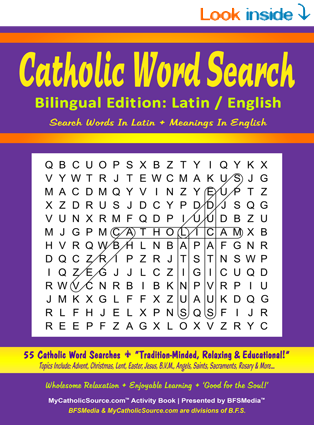
55 Catholic Word Searches ~ "Tradition-Minded,
Relaxing & Educational!"
Topics Include: Advent, Christmas, Lent,
Easter, Jesus, B.V.M., Angels, Saints, Sacraments, Rosary & More...
"Perfect For Catholic
Teens & Adults!" ~ "Great For Home Schoolers!"
Get Your Copy Today!
Why Latin? / Latin Info.
Click link or image above for more information & to purchase.
And...
Catholic
Word Search - Bilingual Edition: French / English
Search Words In French, Meanings In English
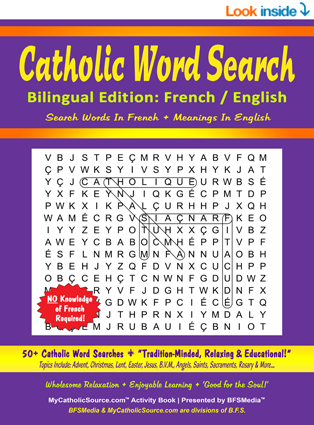
Absolutely NO Knowledge Of
French Is Required!
50+ Catholic Word Searches ~ "Tradition-Minded,
Relaxing & Educational!"
Topics Include: Advent, Christmas, Lent,
Easter, Jesus, B.V.M., Angels, Saints, Sacraments, Rosary & More...
"Perfect For Catholic Teens & Adults!" ~ "Great
For Home Schoolers!"
Fun for any time! Also great for...
* Planning a Catholic pilgrimage to France
* Learning some (or brushing up on some) French
words
* Increasing your French vocabulary
* Adding fun to a homeschool curriculum
* Enjoying a unique challenge, even if you
don't speak a word of French!
Free Sample Here
Get Your Copy Today!
Why Learn French?
Click link or image above for more information & to purchase.
Now Available!
4
Great Inspirational Catholic Coloring Books...




Plus These Handy Coloring Books & Resources...

Lots of Love Coloring Book (Vol.1) - 40 Love-Themed / Affirming Coloring Pages (Easy/Fairly Easy) - "Includes a Variety of Coloring Pages Suitable for Children or Adults!" ~ "Great for Sharing!"

My Colors - Easy & Convenient Color Sample
Sheets ~ Coloring Resources Book: 125+ Assorted Color Sample Sheets - "Perfect
For Testing, Selecting & Organizing Pen, Marker, Pencil or Crayon Colors!"

My Colors 2 - Easy & Flexible Color
Combination Grids ~ Coloring Resources Book: 50+ Color Sample Sheets In 3 Grid
Sizes - "Perfect For Previewing, Testing & Selecting Pen, Marker, Pencil Or
Crayon Color Combinations!"
[Please Note: Proceeds from sales of these books may support My Catholic Source.com]
For More Information & To
Purchase, Click Image(s) Above
Click Here For Coloring Examples
Now Available!
700+ Consoling Thoughts From Holy Scripture
"Inspirational & Uplifting!"
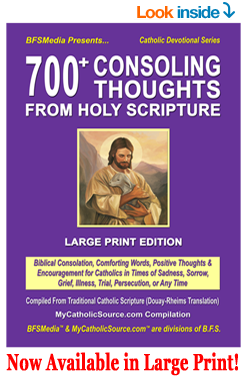
"Some of the most consoling
& comforting words from Holy Scripture, all in one place!"
+ + +
Compiled From Traditional Catholic Scripture
(Douay-Rheims Translation)
Get it today!
+ + +
For More Information & To
Purchase, Click Link Below...
Kindle Version Just $7.99
Notice: Prices are subject to change
without notice and do not include any applicable taxes.
Now Available!
The iStations Book - Stations of the Cross
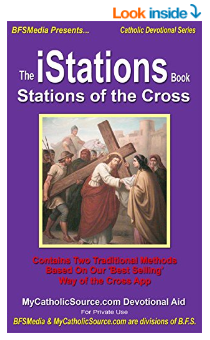
Two Traditional Way of the
Cross Methods for Catholics Based on Our 'Best Selling' App
Features beautiful images, TWO traditional
methods, including a Franciscan method, selected prayers in English & Latin
Get it today!
For More Information & To
Purchase, Click Link Below...
Kindle Version Just $4.99
Notice: Prices are subject to change
without notice and do not include any applicable taxes.
Now Available!
Catholic Annual Prayer Book
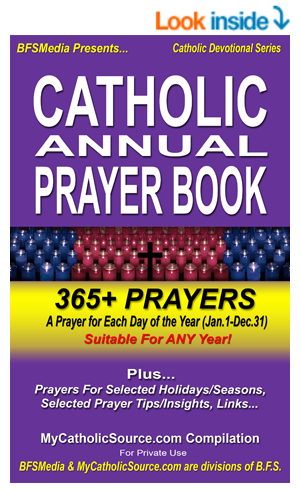
Includes: 365+ Daily Prayers (Jan.-Dec.);
Holiday / Seasonal Prayers; Hundreds of Prayers Indexed by Title;
Nearly 200 Aspirations / Short Prayers; Over 100 Latin Prayers & Aspirations; 500+
Topics for Meditation; Hundreds of Prayer Tips & Insights; And More...
Includes prayers drawn from Holy Scripture, the
liturgy, writings of popes & saints, the Raccolta, the Roman Breviary, the Roman
Missal, etc.
A daily prayer companion for
Catholics that is 'suitable for any year'!
Kindle Version Just $8.99
Notice: Prices are subject to change
without notice and do not include any applicable taxes.
Click Here to Buy
Now Available!
Coloring Book For Catholics: 50+ Latin
Prayers
(Beginning - Intermediate - Advanced)
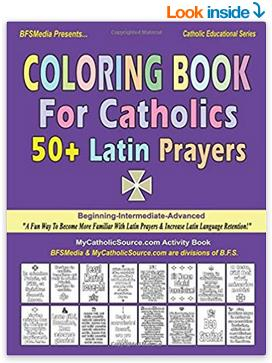
"This 'unique', tradition-minded coloring book
which contains some of the most popular Catholic prayers in Latin is a fun way
to become more familiar with Latin prayers & increase Latin language retention!"
This 'educational & fun' publication is useful
for prayerful relaxation, educational recreation ('learn while you play'),
becoming more familiar with Latin prayers & hundreds of Latin words, learning or
memorizing Latin prayers, increasing Latin retention, and more...
An enjoyable and
instructive tool with respect to Latin (the 'beautiful & majestic language of
heaven' and 'official language of the Church' - a language 'consecrated' by the
inscription on the Cross that helps to foster a universal bond in prayer with
Catholics around the world), this publication is suitable for Catholics of most any
age.
+ + +
"This Catholic coloring book
- which provides hours of wholesome & educational recreation - is so much better
for your soul than television!"
+ + +
Notice: Prices are subject to change
without notice and do not include any applicable taxes.
Click Here to Buy
Now Available!
My Little Latin Mass Coloring Book

25+ Traditional Latin Mass Coloring Images For Children Or Adults [Low
Mass]
"Enjoyable & Educational!"
+ + +
Notice: Prices are subject to change
without notice and do not include any applicable taxes.
Click Here to Buy
Catholic Classics Reprint Now Available!
In Heaven We Know Our Own - Or, Solace for
the Suffering
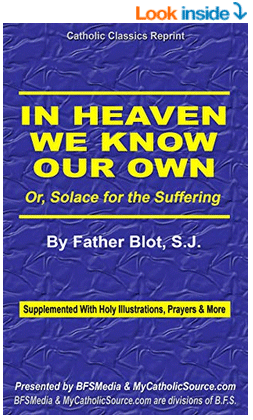
This 'Catholic Classic', which offers consoling
'proof' that the faithful departed remember, love & care for those in heaven and
for those still remaining on earth, is a "great balm of comfort" to those who
have lost a spouse, child, parent, friend, or other loved one. "A thoughtful
bereavement gift, and a 'must-have' for grieving Catholics!"
Get your copy today!
For More Information & To
Purchase, Click Link Below...
Kindle Version Just $2.99!
Notice: Prices are subject to change
without notice and do not include any applicable taxes.
Now Available!
Setting The Record Straight About Luther
Important Things Catholics Should Know About
The 'Reformer'
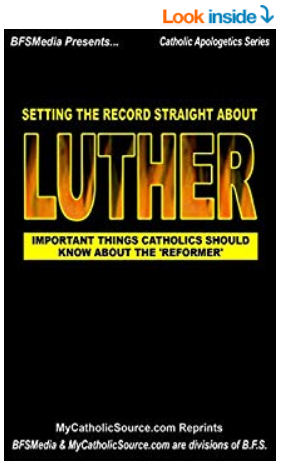
Don't miss this
'eye-opening' treatise concerning Martin Luther, the catalyst / leader of the
' Reformation ' (a.k.a. Protestant Rebellion)
Includes: Facts which demonstrate that Luther
was NOT sent by God, Luther received approval of his teaching from Satan,
Luther's misbehavior, some results of Luther's teachings, Luther admits he could
be wrong, and more...
Get your copy today!
For More Information & To
Purchase, Click Link Below...
Kindle Version Just $5.99
Notice: Prices are subject to change
without notice and do not include any applicable taxes.
Now Available!
BIG Book of Latin Activities For Catholics
Beginning - Intermediate (Vol. 1)
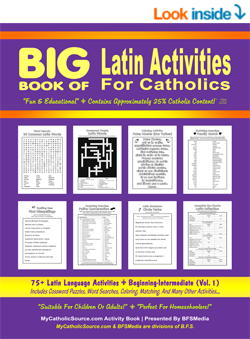
"Suitable For Children Or
Adults!" ~ "Perfect For Home Schoolers!"
+ + +
As many faithful Catholics already know,
the majestic
Latin language – the 'official language' of the Catholic Church –
promotes unity, helps safeguard the purity of doctrine, connects us with
our Catholic ancestors, allows us to pray in "one voice", and even ties
back to the inscription on the Cross which was written in Hebrew, Latin,
and Greek. The Latin language is still used today in the precious
treasure that is the
Traditional Latin ('Tridentine') Mass, in 'everyday speech' (much of
English is derived from Latin), in mottos, in specialized fields, and in
educational endeavors. It has been shown that the study of Latin brings
many benefits. "And, Latin is truly the language of heaven!"
If you enjoy Latin, you may be glad to know that
this full-sized (8.5" x 11"), tradition-minded publication features an
assortment of activity types related to Latin (including: word searches,
crosswords, coloring activities, challenges, fill-ins, spelling bee,
quizzes, unscrambles, true/false, multiple choice, matching, cross-offs,
circling, word associations, translation exercises, and more...), and
treats of various topics (including: common Latin words, Latin language
facts, Latin grammar, nouns & verbs, abbreviations,
phrases / sayings / mottos, prefixes, cardinal numbers, grammatical gender,
inflection, word roots, diacritics / accenting, pronunciation, Latin
prayers / hymns, Scripture verses, Catholic phrases, and more...).
+ + +
" Fun & Educational! "
Get Your Copy Today!
Click Here For More Information & To Purchase
Now Available!
Activity Books For Kindle Scribe

Write-On Books For Scribe!
Click Here For More Information
Try Here For Great Catholic Apps!
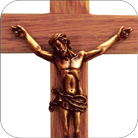
My Crucifix
For the iPad®, iPhone®,
and iPod touch®...

For the iPad®...





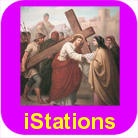



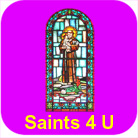



And Other Great Apps...











More My Catholic Source.com Media: Books & Ebooks
|
|
|
|